MISCELLANEOUS TECHNIQUES OF TIGER-CRANE SET

Editorial Note: About 45 years ago in the 1970s, the most authoritative Chinese kungfu magazine then, “Xin Wu Xia” (“New Martial Hero”), published a series of articles with Sifu Wong's commentary on the Tiger-Crane Set. The series consists of four articles, namely:
- Similarities and Differences of Tiger-Crane Sets
- Combat Sequences of Tiger-Crane Set
- Miscellaneous Techniques of Tiger-Crane Set
- Training Methods of Tiger Claw
This article on “Miscellaneous Techniques of Tiger-Crane Set” is the third of the series. The sentence structure in this English translation follows that in the original Chinese version.
Miscellaneous Techniques of the Tiger-Crane Set
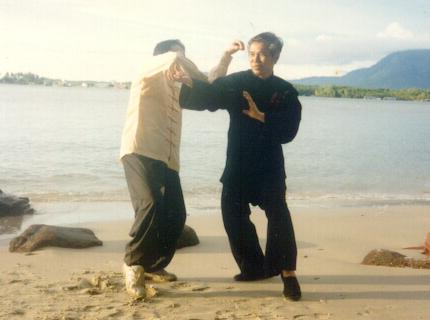
A recent photograph showing Sifu Wong and his senior disciple, Goh Kok Hin, demonstrating a combat application of the Tiger-Crane Set. As Sifu Wong grips Goh Kok Hin's elbow with a Tiger Claw (please see the illustration on the previous page in the series), Goh Kok Hin shifts his left False Leg Stance to a right False Leg Stance and strikes Sifu Wong's right temple with his left Crane Beak in a pattern called “Satisfied Reincarnated Crane”.
In the previous two issues, the principles as well as the combat sequences of the Tiger-Crane Set were explained. The Tiger-Crane Set has both “hard” and “soft” dimensions, and the famous “No-Shadow Kicks” of Shaolin. Students should understand the principles and application of the set. Having learnt the patterns of the set, students should practice its combat application, and understand its variations.
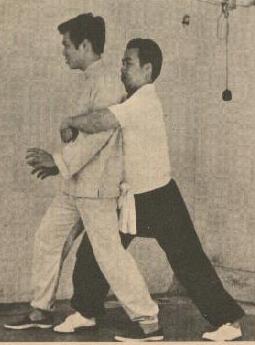
Weng Tuck, grabs Sifu Wong from behind with both arms.
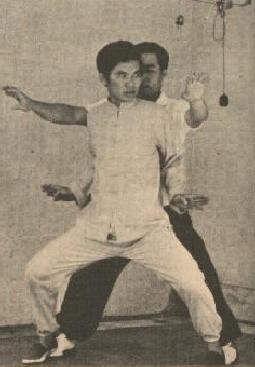
Sifu Wong jumps up and lands his heels on the opponent's toes, while his elbows simultaneously strike the opponent's ribs. It is important that Sifu Wong turns to his left as he jumps so as not to land on the opponent's knee.
In this issue I shall explain the “san shou” or miscellaneous techniques of the set. What are miscellaneous techniques? Using each one pattern or a series of patterns in the set to meet miscellaneous combat situations, that is miscellaneous techniques.
For example, if an opponent grabs you from behind with two hands, as in the illustration above, how would you meet this combat situation?
The pattern “Flying Bird Flaps Wings” from the Tiger-Crane Set can be used to counter this attack. The photographs illustrate these miscellaneous techniques.
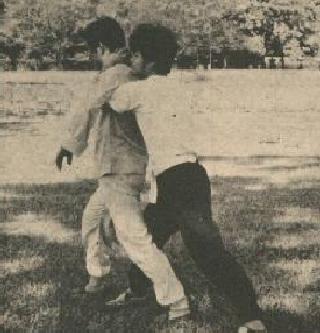
Yow Ba uses the pattern “Tai Mountain Presses on Head” to lock Sifu Wong's head.
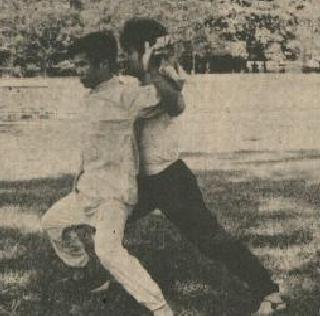
Sifu Wong uses the pattern “Fierce Tiger Returns to Highland” to grip Yow Ba's fingers and turn them outward to release the lock
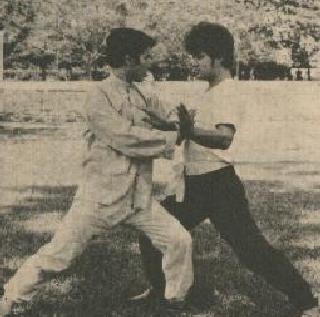
Sifu Wong immediately shifts his footwork and strikes Yow Ba's solar plexus with his elbow.
Miscellaneous techniques and combat sequences are very important aspects of kungfu sets. Students must realize this. If students merely learn kungfu sets, and desire to learn more and more kungfu sets, they may unknowingly neglect the utmost importance of miscellaneous techniques and combat sequences. In this way their kungfu sets will become merely demonstrative forms, without any practical combat functions.
It is hoped that students will understand this point, and prevent the essence of the Chinese martial art degenerating into flowery fists and embroidery kicks. Kungfu practitioners must take up this responsibility and promote the essence of the art.

Wong Weng Tuck executes a side kick at Sifu Wong. Sifu Wong moves a small step to his right and lock the kicking leg with the pattern “Tiger Leans Against Wooden Door”.
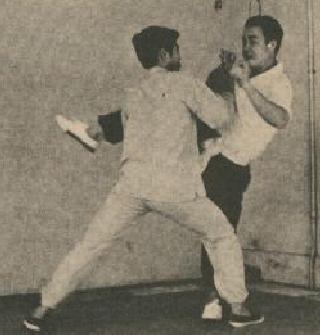
Immediately Sifu Wong moves a big step forward and pushes Wong Weng Tuck away, using the pattern “Fierce Tiger Pushes Mountains”.

Yow Ba grips Sifu Wong's neck and strikes with his knee at Sifu Wong's ribs.
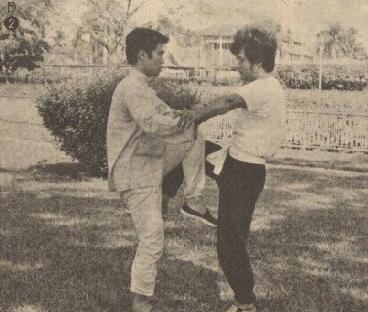
Sifu Wong counters the knee strike with the pattern “Single Legged Flying Crane” using “soft” force to release the grip on the neck, and simultaneously using the knee to deflect Yow Ba's knee strike. Immediately Sifu Wong kicks at Yow Ba's groin.
In practicing miscellaneous techniques and combat sequences, it is not true that there must be two persons practicing; it is also possible for a single person to practice alone. When practicing alone, imagine an opponent in your mind. The objective is to perform the patterns with force, speed and fluidity, so that in real combat the patterns can be implemented naturally.
In the next issue I shall explain the methods of training the Tiger Claw of the Tiger-Crane Set.
